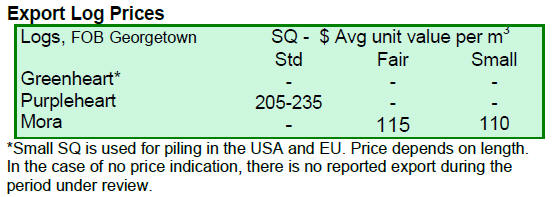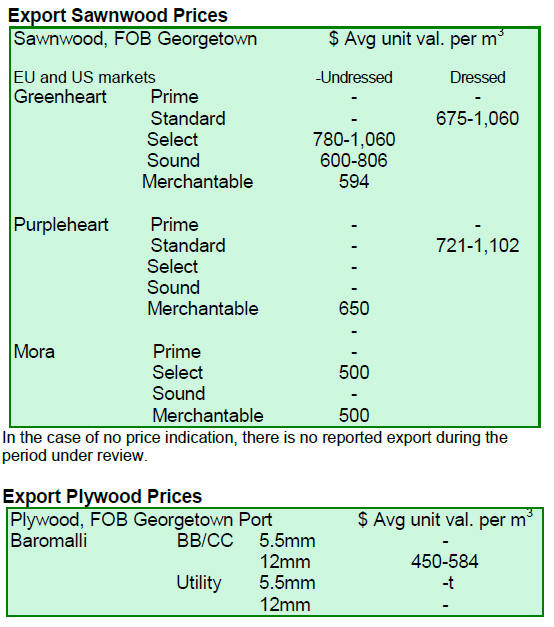2. GHANA
Improving wood supply to domestic market
key to
eliminating illegal logging
The Minister for Lands and Natural Resources, Alhaji
Fuseini, said the Forestry Commission would continue to
implement activities under the National Forestry
Plantation Programme so as to improve the supply of
timber to the domestic market and at the same time satisfy
the public wood procurement policy.
The Minister made this known at a press conference in
Accra where he also announced Ghana¡¯s gold production
in 2012 was the highest in the history of the country
amounting to over 4 mil. ounces worth almost US$6
billion.
As demand for sawnwood in the domestic market grows
there is an urgent need for the government increase
plantation output which will help reduce the incidence of
illegal logging.
The minister said the Forestry Commission has established
a Rapid Response Unit to clamp down on illegal activities
within the forest reserves and protected areas.
Low prices affects export earnings from
nontraditional
products
Revenue from Ghana¡¯s non-traditional exports (NTEs)
which does not include timber, cocoa beans and minerals
fell around 4% in 2012 to US$2.3 billion.
According to the Ghana News Agency, available figures
show that exports of processed and semi-processed goods
contributed about 90% to total earnings, with agricultural
and handicraft products making up the balance.
Europe remains the main destination for non-tradional
exports and accounted for about 50% of the total in 2012.
The 15 member ECOWAS countries accounted for 31% of
export sales.
According to the acting Chief Executive of the Ghana
Export Promotion Authority (GEPA), Mr. Gideon Kwame
Boye Quarcoo, the decline in the 2012 revenue could be
attributed to a general weakening of prices.
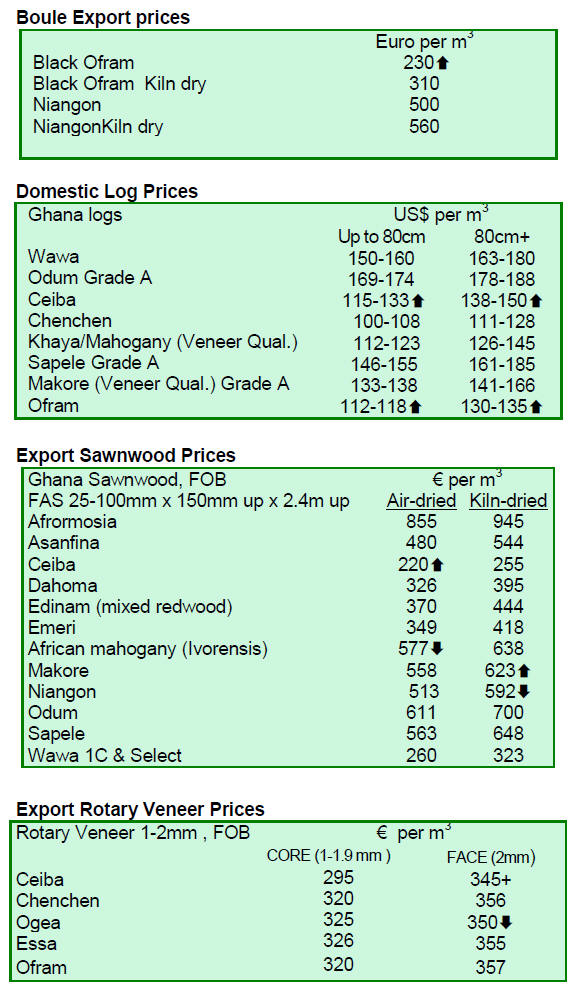
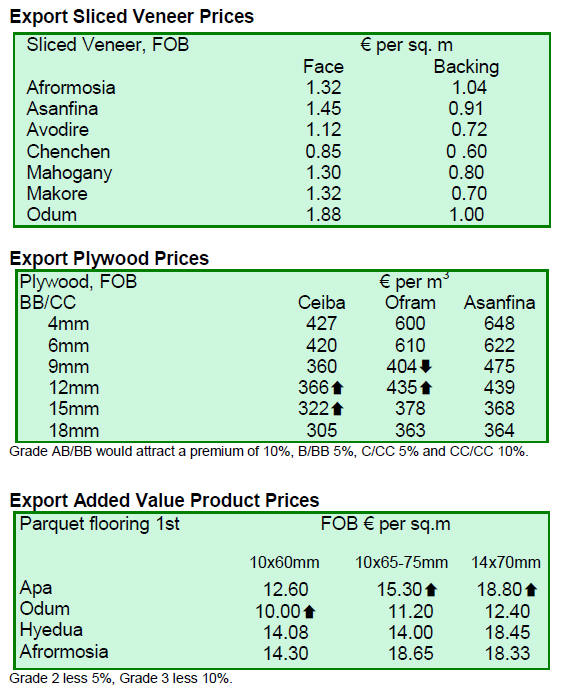
3. MALAYSIA
Smoke haze eases in Peninsular Malaysia
The smoke haze problem in Peninsular Malaysia has eased
considerably because of a change in the weather. Heavy
rain in Indonesia has contributed to the efforts of the
authorities to bring the fires under control.
The Indonesian President Susilo Bambang Yudhoyono has
offered an apology to the people of Singapore and
Malaysia for the thick smoke haze from raging fires in
Sumatra. In his message the Indonesian President said ¡°we
accept the smoke pollution is our responsibility and we
will tackle the problem¡±.
In related news it seems that the Indonesian police are
investigating a Malaysian firm having plantations in
Sumatra as this company is thought to be responsible for
one of the major forest fires.
Number of forest rangers to be doubled
Increased public awareness of environmental issues,
possibly sharpened as a result of the current smoke haze,
has prompted the Malaysian Minister of Natural Resources
and Environment, G Palanivel, to announce that the
permanent forest cover in Peninsular Malaysia will be
extended to five million hectares from the present 4.7
million hectares.
BERNAMA, the national news agency, has reported the
minister as saying, ¡°the health of the forest is an important
issue for the country, not only as a source of income, but
also for the protection and conservation of flora and fauna.
Efforts must be made to ensure sustainable
forest
management and to prevent poaching and illegal killing of
endangered animals¡±.
The Malaysian government has agreed to double the
number of forest rangers to help manage, monitor and
protect forest resources. Presently, Malaysia has about
2000 forest rangers stationed in permanent forest reserves
spread across the country.
Drive on to get more companies to register with MTIB
Industry analysts report that officials from the Malaysian
Timber Industry Board (MTIB) have mounted a campaign
to get more wood product manufacturers, especially
furniture producers, to register with MTIB. It is thought
that this is in preparation for further negotiations with the
EU on a VPA.
Persistent power failures affecting production in
Sabah
It is perhaps fortunate that the timber industry in Sabah is
experiencing quiet trading conditions as mills are suffering
from power failures.
The Sabah Timber Industries Association (STIA) recently
called for urgent action by the federal and state
governments to solve the continuing problem over power
failures in the Seguntor Industrial Area where many
timber companies have production facilities.
STIA told the Daily Express newspaper their records show
there were 662 hours of downtime in 2011, and 106 hours
without power in 2012. The STIA says power outages this
year are already over 500 hours.
India remains number one Sarawak log buyer
The Sarawak Forestry Department reported that in the
period January to April 2013, the State produced a total of
2,596,901 cu.m of logs. Swamp species contributed only
67,483 cu.m, while the remaining harvest was of hill
species.
Of the total log production, 1,000,304 cu.m were exported.
Log exports for the first four months of 2013 were worth
around RM 572 mil.
For the year to-date India is the leading buyer of logs
having bought 606,583 cu.m (worth RM 370 mil.) and
Taiwan P.o.C was second, purchasing 149,974 cu.m (RM
85 mil.). China was the third largest buyer at 93,920 cu.m
(RM 44mil.).
Imports by these countries are followed by Vietnam
66,596 cu.m (RM 29 mil.) and Japan 44,852 cu.m (RM 29
mil.). From being the main buyer of Sarawak logs Japan is
now only the fifth ranked importer.
Imports of Sarawak sawnwood by Philippines and
Thailand top 76,000 cu.m
In the January to April 2013 period, Sarawak exported a
total of 271,573 cu.m of sawntimber worth RM 237 mil.
Importers in the Philippines bought the most at 76,686
cu.m (worth RM 29,670,539) and Thailand was the second
largest buyer at 76,226 cu.m (RM 74,898,825).
Yemen was the third biggest buyer of sawntimber at
34,041 cu.m (RM 41 mil.), followed by Taiwan P.o.C at
21,866 cu.m (RM 17 mil.). Buyers in Singapore purchased
10,201 cu.m (RM 11 mil.).
Product and market diversity brings rewards
In the year to April 2013 Sarawak exported a total of
976,600 cu.m of plywood (worth RM 1,418 mil.).
Japan was the main buyer at 545,718 cu.m (worth RM 799
mil.) and South Korea was number two at 106, 330 cu.m
(RM 136 mil.).
Third biggest buyer was Taiwan P.o.C at 98,544 cu.m
(RM 135 mil.), followed by Yemen 49,461 cu.m (RM 62
mil.) and Egypt at 39,745 cu.m (RM 58 mil.).
The value and volume of veneer exports from Sarawak in
the year to April 2013 totalled 63,596 cu.m (worth RM 73
mil.).
In addition, 2,040 cu.m of mouldings were exported
earning RM 5 mil. along with 40,761 cu.m of
particleboard (RM 19 mil.); 63,814 cu.m of MDF (RM 90
mil.); 5,061 cu.m of laminated board/flooring (RM 12
mil.) and, 105,800 tonnes of woodchips/particles (RM 20
mil.).
¡¡
4. INDONESIA
Error in EU statistics, Indonesia
furniture exports to
EU fall sharply
In the June issue of this market report statistics on
Indonesian furniture imports by the EU were presented.
Specifically our report said:
¡°Indonesia¡¯s Ministry of Trade has data (from the EU)
showing wood product exports, mostly furniture, more
than doubled to US$416 million in the first quarter of this
year, compared to US$194 million in the same period last
year¡±.
As yet unconfirmed reports say that the data provided to
Indonesian authorities by the EU was incorrect due to a
statistical error in Belgian import data.
The value of the Belgian imports of Indonesia furniture in
January 2013, as provided by the Belgian Statistical
Office, was not euro 200 million.
It is more likely that imports were in the region of euro 4-5
million. The Belgian Statistical Office said it will publish
revised data in September 2013.
It is now forecast that first quarter 2013 EU imports of
furniture from Indonesia will be around euro 100 million
instead of the euro 296 million reported by the EU. If this
is the case then EU imports of Indonesian furniture
actually fell around 15%.
Illegal logging bill approved after 11 years
The Indonesian parliament has now approved a bill on
prevention and eradication of deforestation but this has
attracted criticism from environmentalists who say the
Ministry of Forestry has been given too much authority
under the new law.
The draft legislation was first submitted in 2002 as an
illegal logging bill but debate on the bill was delayed such
that it was first discussed by the House only in 2010.
The deputy chairman of House Commission IV overseeing
agriculture and forestry, Firman Subagyo, said the initial
draft only dealt with illegal logging but that since its
introduction to the House there was a clear need to expand
the legislation to include deforestation.
Firman said this legislation would go a long way to
providing the means for the Ministry of Forestry to
effectively protect the country¡¯s natural forest.
Environmental groups had strongly opposed the text of the
draft because of concerns it could result in indigenous
communities being denied access to the forests on which
they depend. Appropriate changes were made to the draft
before it was debated and approved.
The Minister of Forestry, Zulkifli Hasan, has reaffirmed
that the powers vested in his ministry to address illegal
logging and deforestation would not be used against
indigenous communities.
Indonesia-Australia Kalimantan Forest Conservation
Partnership to be reassessed
The Australian government has indicated it will not extend
the Indonesia-Australia Kalimantan Forest Conservation
Partnership in its present form and will halt a project in
Indonesia to restore and protect forests and peatland in
Kalimantan.
The Australian prime minister has met with his Indonesian
counterpart to discuss which elements of the original
project could be supported in the future.


¡¡
5. MYANMAR
Teak log sales
The following prices were recorded for teak log sales
during competitive bidding on 21st and 24th June 2013
during the Myanma Timber Enterprise tender. The next
tender sale is in late July.
 Teak harvests
to be drastically reduced
Teak harvests
to be drastically reduced
The State-run newspapers the Mirror Daily and the New
Light of Myanmar has reported that Myanma Timber
Enterprise (MTE) is drastically cutting its annual
harvesting.
MTE is still the sole agency responsible for harvesting,
extraction and distribution of logs in Myanmar.
This reduction in harvest is said to be with a view to
stopping the decline in forest cover in the country.
Maintaining the forest cover is seen as key to
preventing
natural disasters, especially floods, as more efficient water
resource management will be possible.
The newspapers also reported that MTE harvested about
268,900 Hoppus tons (HT) of teak and 1,391,600 HT of
other hardwoods during the financial year 2012-13. The
target for 2013-14 will be about 180,000 HT teak and
about 800,000 HT of other hardwoods.
Analysts suggest the sharp reduction in harvests is to take
account of the current processing capacity in the country
which is insufficient to handle the volume of logs that
would become available if past annual harvest levels were
maintained after the log export ban is introduced in April
2014.
The Daily Eleven newspaper of 10 July reported that in
answer to questions in the Amyotha Hluttaw (Upper
House of Parliament), Win Tun, Minister of
Environmental Conservation and Forestry (MOECAF),
said 600,000 HT of hardwood logs will be sold by open
tender to private saw-millers in the country to satisfy
domestic sawnwood requirements.
He also mentioned that, compared to harvest levels last
year, teak harvests would be reduced by 40% and harvests
of non-teak hardwoods will drop 45%.This is a very
significant reduction in log harvests.
Under these circumstances analysts with long working
experience with MTE are making informed guesses on the
availability of logs for export sales during the current
fiscal year. Of the teak logs to be harvested this year more
than 20,000 HT will be requited by mills and plant run by
the MTE leaving only about 160,000 HT for export in log
form.
Of the 800,000 HT of non-teak hardwood logs to be
harvested this year about 600,000 HT is expected to be
processed by domestic mills, about 100,000 HT will be for
the MTE plywood factories and other plants and MTE will
have to supply about 100,000 HT to joint venture
companies producing plywood and other wood based
products.
If these assumptions are correct, say analysts, the planned
harvest reduction will leave few logs available for export.
Until now Myanmar relied on the export of logs and sales
of value added products for income generation but with
the proposed harvest reductions the country may not be
able to achieve its export earnings target.
Greenply Industries of India invests in Myanmar
Daily Eleven News reported that the Myanmar Investment
Commission has approved an investment by an Indian
based company, Greenply Industries Ltd. (India), for
production of wood based products.
A new production facility will be built at the Dagon Port
Industrial Zone.
In related news the paper quoted an official from
MOECAF as saying Asian, US, and EU investors are also
planning to invest in the wood processing sector in the
country.
¡¡
6.
INDIA
Smuggling of red sanders continues
Illegal felling and smuggling of high value timber is in the
news again in India. The Enforcement Directorate of India
has intercepted 13 containers containing 200 tons of red
sanders and has arrested the trader and seized his assets.
The Indian media are saying that just this one trader
exported more than Rs.1000 million before the arrest.
This much sought after wood ultimately ends up in several
of the main Asian markets where it is used for the
manufacture of musical instruments amongst other high
value items. While this single arrest is a step in the right
direction analysts in India can only guess at how much
more of this precious wood is being smuggled by how
many other traders.
Sales of teak and other hardwoods at western Indian
forest depots
Auctions were held at Ahwa, Borkhet, and Waghai depots
of the Dangs Forest Division. Auctions were also held at
various depots of the Rajpipla and Vyara Forest Division.
Approximately 7,000 cubic metres of teak and about 4,000
cubic metres of non-teak hardwoods were sold.
Because the monsoon has set in buyers know that future
auctions may be postponed so there was active bidding for
the available logs which pushed prices slightly higher than
in previous auctions.
Average prices recorded at the most recent auction are as
follows:
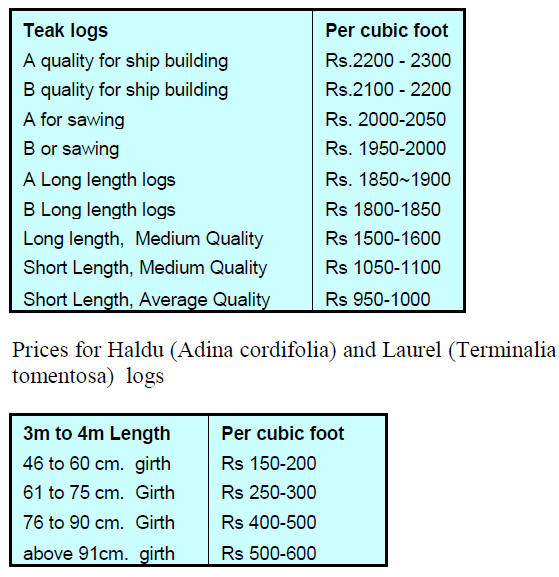
Plantation teak imports
Plantation teak imports have slowed due mainly to the
sharp depreciation of the rupee against US Dollar, the
main currency used in this trade. Indian importers try to
effect payments quickly so as to secure the best exchange
rate as the rupee continued to weaken.
Current prices, C & F Indian ports per cubic metre are
shown below.

Variations are based on quality, lengths of logs
and the average
girth of the logs.
Domestic prices for sawnwood
The domestic prices for air dried sawnwood remained
unchanged over the past two weeks.
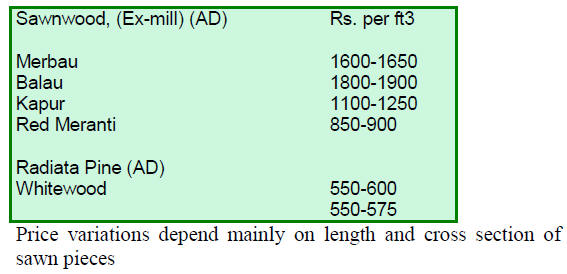

Monsoon planting season underway
The monsoon has arrived in India and this is the time for
planting. The Forestry Departments of many states are
cooperating and distributing saplings of fruit bearing trees
which also yield good quality of timber such as jack fruit
(Artocarpus spp,) jambhul (Eugenia spp,) kokum
(Garcinia spp.), wild badam (Terminalia catappa) and
tamarind (Tamarindus indicus).
Nurseries in Mangalore are distributing sandalwood and
red sanders saplings in addition to teak and mahogany.
According to a press release from the Maharashtra
Forestry Department during last year¡¯s planting season the
state government supported the planting 77 million
saplings over an area of 75,000 hectares and for this
season they have prepared 145 million saplings.
Products from many trees in India have medical uses
and
quite a few are of religious significance also. Such trees
include ashok (Ashoka sarica), bael or bilva (Aegle
marmalosa), sacred fig, Peepal (Ficus religiosa), banyan,
(Ficus bengalenses) and nagkesar (Mesua ferrea). Such
trees are also planted during the monsoon period.
Himalayan state of Uttarakhand launches disaster
early warning initiative
Last month the Indian Himalayan state of Uttarakhand
suffered devastating flash floods and land slides after three
days of extremely heavy rain. The flood and landslides
resulted in unprecedented devastation and loss of life and
property.
The state authorities believe the extent of the disaster was
made worse because of heavy deforestation, uncontrolled
mining activity and building along river banks. More than
10,000 are feared dead and the government is still
assessing the extent of casualties.
To limit damage from such disasters in the future the state
government has launched a programme which will provide
regular assessments of the status of glaciers, forests, rivers,
soil etc. to be used as a basis for disaster prevention
initiatives.
7.
BRAZIL
Tax hike hits wood product
manufacturers
The tax on industrialised products (IPI) was raised as of 1
July and this has affected furniture, wood panel and veneer
manufacturers. The new IPI rates for these three products
will go from 2.5% to 3% and will be effective until a
review in September.
The Ministry of Finance pointed out that they have no
room for exemptions and asked the timber sector
representatives not to pass along the tax increase to
consumers to avoid adding to inflationary pressures.
According to the Institute for Retail Development of
(IDV), there is a dilemma between the government's
commitment to fiscal adjustment and the desire to
maintain the competitiveness of the items listed in the
programme. Representatives of Walmart Brazil say that
this change in tax rate will have a major impact on sales
Partnership benefits small furniture companies
A furniture cluster in Belo Horizonte, Minas Gerais state
will benefit from the recently launched Technology
Services Network (Rede de Serviços Tecnol¨®gicos - RST).
The RST will benefit almost 200 micro and small
companies in the city of Belo Horizonte and the
municipalities of Par¨¢ de Minas and Carmo do Cajuru in
the Midwest region of the state. The RST has a budget of
R$ 2.6 million for activities until 2016.
The RST is a project within the Supporting Service for
Micro and Small Businesses (SEBRAE) implemented in
partnership with the Inter-American Development Bank
(IDB) and the Center for Technology and Quality of
Furniture Industry (Cosmob), with support from the
United Nations Development Program (UNDP) and the
Multilateral Investment Fund (MIF).
The objectives of the RST include improving the quality
of furniture parts manufactured by small companies,
improving manufacturing processes and introducing the
application of advanced design methods. Incentives will
be provided for the development of prototypes and
investigation of new technologies appropriate to the
sector.
In 2008, in the states of Amazonas and Par¨¢, a similar
programme was implemented called the SEBRAE-IDBCosmob
partnership. The idea was to create
competitiveness and disseminate technical solutions
suitable for small companies.
After the successful experience in the Amazon, the state of
Minas Gerais will now implement a similar project after
which the project activities will be extended to the
furniture sector of Arapongas, in the state of Paran¨¢. In
total, the RST project, with a budget of R$ 16 million, will
involve 1,214 companies.
Amazon fund approval for forest monitoring project
The Brazilian Development Bank (BNDES) has offered
RS 23 million from the Amazon Fund to the Organization
of the Amazon Cooperation Treaty (OTCA), an
intergovernmental organization formed by Bolivia, Brazil,
Colombia, Ecuador, Guyana, Peru, Suriname and
Venezuela, whose territories comprise about 99% of the
Amazon biome.
With this latest disbursement the Amazon Fund will have
invested in 37 projects valued at R$462, 8 million the aim
of all projects is to address deforestation and sustainable
development.
The Amazon Fund initiative began in 2011 and has the
support of the Brazilian Ministry of Foreign Affairs and
the Ministry of the Environment which includes the
National Coordinating Institution for deforestation control.
The Brazilian National Institute for Space Research
(INPE) will participate in the project providing training
and technology for the forest cover monitoring. This
technology was developed with support from the German
agency for international technical cooperation and the
International Tropical Timber Organization.
Currently there are no accurate data on the forest cover
and deforestation in the OTCA countries, except Brazil.
This project ¡°Forest Cover Monitoring in the Amazon¡±
will deliver support to other OTCA countries in respect of
satellite image analysis, access to forest cover monitoring
technologies, national forest monitoring planning as well
as harmonisation of institutional capacity for land use
change monitoring and surveys.
The programme will also support regional cooperation to
combat illegal deforestation and the sharing of experiences
related to public policy instruments for the reduction of
deforestation rates.
Rio Grande so Sul regains leadership in furniture
exports
The state of Rio Grande do Sul (RS) has once more taken
the lead in terms of international sales of furniture with
US$ 76 million exported between January and May 2013,
a 4.9% increase compared to the same period in 2012.
The second ranked exporter was Santa Catarina state with
just over US$ 75 million in exports, a 2.9% drop from the
same period in 2012. Exports of furniture from Paran¨¢ and
São Paulo trail the leaders.
The main countries that imported furniture from Brazil up
to May this year were Argentina (US$52 million), the
United States (US$ 38 million), the United Kingdom
(US$30 million) and Peru (US$16 million).
Furniture from Rio Grande do Sul was exported mainly to
the UK (US$10 mil.), followed by Uruguay (US$9.8 mil.),
Peru (US$8.6 mi.) and Chile (US$8.3 mil.).
According to the Association of Furniture Industries of the
State of Rio Grande do Sul (MOVERGS), there are still
serious obstacles hampering growth of furniture exports
from Rio Grande do Sul. The association has said the state
needs a robust trade policy to increase competitiveness of
the furniture sector.
Price movements
Prices of wood products in the domestic market increased
by around 0.3% compared to prices in the previous
fortnight.
The values in US dollars, as shown in the table below,
below fell on average by 4.6% because of the depreciation
of the Brazilian currency against the US dollar.
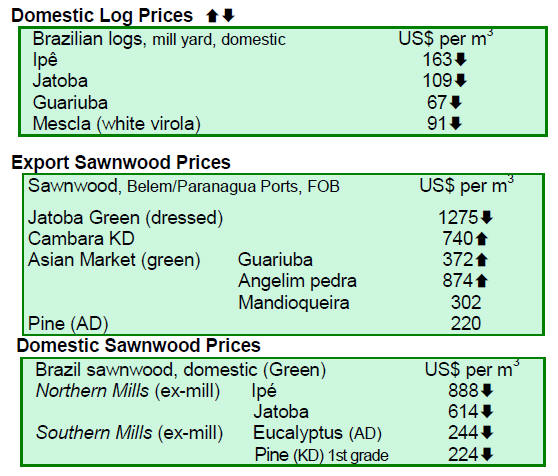
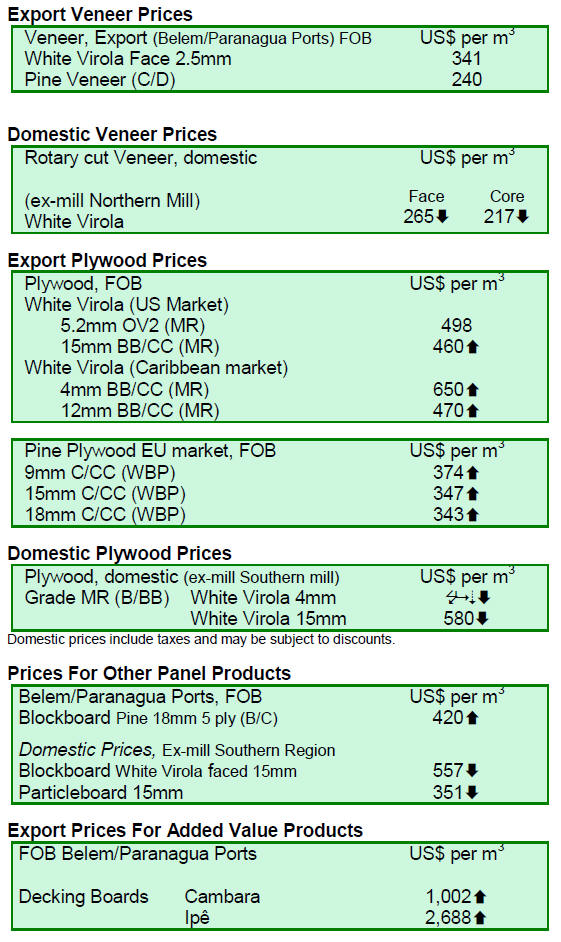
¡¡
8. PERU
Exports fall 15 percent
According to the Export Association of Peru (ADEX),
exports in the period January ¨C April 2013, were US$47.2
million FOB compared to US$55.5 million FOB in the
same period last year representing a decline of almost
15%.
To-date, the three main export markets were China,
Mexico and United States and these three markets
accounted for just over 70% of all wood product exports.
Imports by the Dominican Republic increased
significantly over the previous year.
The main product of interest in the Chinese market was
hardwood flooring while for the US the two most traded
items were kiln-dried sawnwood and plywood.
China actively buying sawnwood and processed
products
Exports of sawnwood in the period January ¨C December
2012 represented the 38% of all wood product exports and
for 2013, up to April, sawnwood exports totalled US$18.1
million FOB but in the same period in 2012 the value of
sawn exports was US$22.9 million FOB.
Sawnwood from Peru was shipped mainly to buyers in
China which accounted for about 30% of all sales up to
April 2013.
Exports of semi-manufactured products up to April this
year accounted for 37% of all wood product exports. The
cumulative value of exports of semi-manufactured
products up to April this year was US$17.3 million FOB
representing a decline of over 10% on the value of exports
in the same period in 2012.
Once again the main market for semi-manufactured wood
products was China (58%) however, demand in Mexico
and Sweden improved significantly compared to the same
period in 2102.
US the main market for veneer and plywood exports
Exports of veneer and plywood up to April 2013 were
US$5.6 million FOB compared to the US$7.2 million in
the same period in 2012 representing a 23% drop. The US
is the main market for veneer and plywood exports and
this market accounted for 62 % of all exports of these
products.
Exports of furniture and furniture parts had been growing
over the past few years but, for the year to-date, the value
of exports is down. Up to April 2013 exports of furniture
and furniture parts totalled US$ 2.3 million FOB a drop of
around 7% on the same period in 2012.
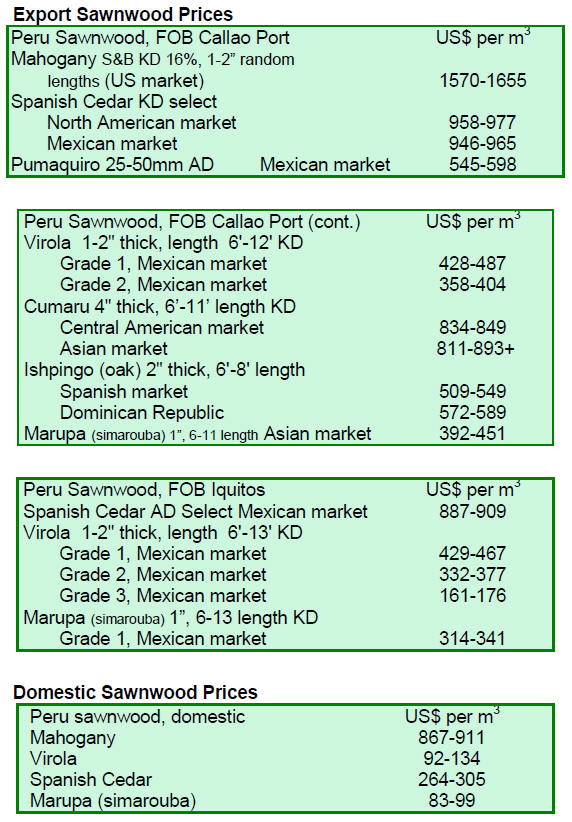
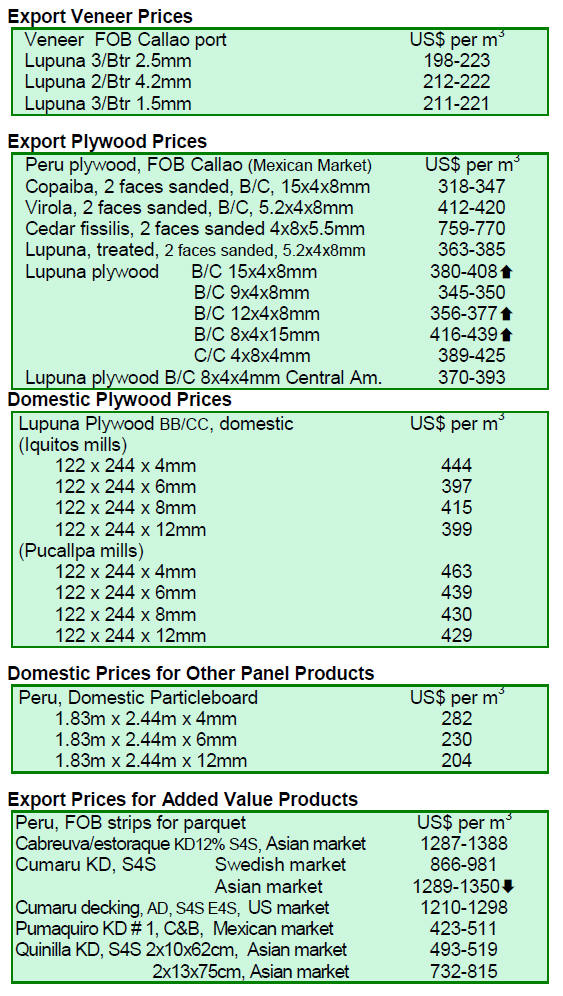
9.
GUYANA
Wamara log exports to China
In the period under review there were no log exports of
major commercial species except wamara (Swartzia
leiocalycina) which was exported to buyers in China at
acceptable prices in the region of US$120 per cubic metre.
On the other hand sawnwood exports held up and prices
were considered favourable during the period reviewed.
Good prices secured for sawn greenheart and
purpleheart
Sawn Undressed greenheart (select) top end FOB prices
increased from US$1,060 to US$1,230 per cubic metre
and greenheart (merchantable) export prices were also
favourable at US$636 per cubic metre FOB.
The main markets for this prime timber were Caribbean
nations, Europe and North America.
Undressed purpleheart (select) FOB prices moved up and
the best price secured was US$1,100 per cubic metre FOB.
The main markets for undressed purpleheart include North
America and the Oceania countries.
Undressed mora (select and sound) is in demand in
the
markets of Australia, the Caribbean, Europe and North
America. Export FOB prices were good at US$500 per
cubic metre. Dressed mora sawnwood export prices
remain unchanged.
Firm demand in Caribbean markets but washiba is the
favourite in N. America
Dressed greenheart low end price saw an increase from
US$675 to US$721 per cubic metre FOB while top end
FOB prices remained unchanged at US$1,060 per cubic
metre.
Dressed purpleheart prices remained unchanged during the
period reviewed. In recent weeks demand from buyers in
the Caribbean has grown for the prime commercial timber
species from Guyana.
Guyana¡¯s ipe is attracting favourable prices in the export
market and recently prices moved as high as US$ 2,550
per cubic meter FOB.
Splitwood export prices can in firm and averaged
US$1,023 per cubic metre FOB in the Caribbean and
North American markets.
Guyana Expo 2013 focuses business partnerships for
delivery of low cost homes
The construction and real estate sectors contributed an
average of around 11 percent to GDP over the past four
years and the value of output from the two sectors in 2012
ranked the fourth largest after agriculture, wholesale and
retail services and mining.
The recent Building Expo 2013 focused on the
development of partnerships between local companies and
those form outside the aim being diversification of the
production base.
The minister of the Central Housing and Planning
Authority, Irfaan Ali, said that there has been tremendous
growth in the housing sector over the past four years as
part of the government¡¯s effort to create a winning
environment ¡°we must build tomorrow¡¯s infrastructure
today therefore major projects that the government is
engaged in now will definitely boost Guyana¡¯s economy,¡±
said the minister.
Private Sector Commission Chairman Mr. Ronald Webster
emphasised the significance of the construction sector to
Guyana¡¯s economic well being. He said that globally the
construction and real estate sectors are the cornerstone of
economic growth.
